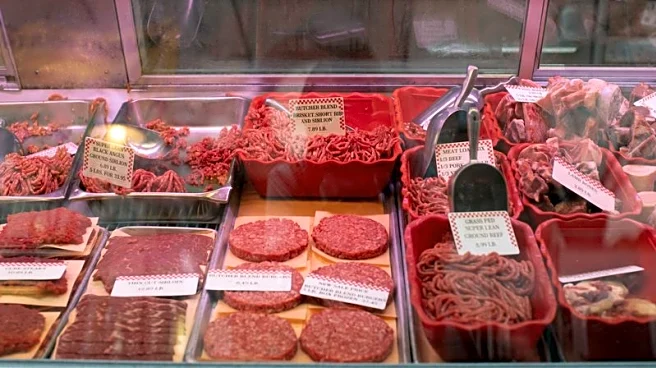What's Happening?
Beef prices in the United States are expected to rise significantly, potentially reaching $10 per pound by the third quarter of 2026, according to Omaha Steaks CEO Nate Rempe. This prediction comes amid a 70-year low in the U.S. cattle herd and soaring
demand for beef. Rempe highlighted that ranchers are holding onto heifers to rebuild herds, which is contributing to a reduced beef supply in the near term. The current average price of ground beef is $6.323 per pound, marking a 14% increase since January and a 26% rise from January 2024. President Trump has announced the removal of tariffs on beef and other commodities, but non-tariff factors such as droughts, high interest rates, and expensive feed are driving the price increase. Rempe also noted that while imports from countries like Argentina are being considered, they only account for a small portion of U.S. beef supply.
Why It's Important?
The anticipated rise in beef prices could have significant implications for American consumers, particularly affecting affordability and household budgets. The price increase may exacerbate economic pressures on families, especially those with lower incomes. Additionally, the beef industry may face challenges in meeting domestic demand, potentially leading to increased reliance on imports. President Trump's actions to remove tariffs and address alleged price manipulation by meat producers could influence market dynamics and consumer prices. The situation underscores the broader economic impact of agricultural supply chain issues and the importance of strategic policy interventions.
What's Next?
As beef prices continue to rise, consumers may need to adjust their purchasing habits, potentially opting for alternative protein sources or different cuts of meat. The U.S. government may further investigate alleged price manipulation in the meat industry, as indicated by President Trump's call for the Department of Justice to take action. Meat producers might explore technological solutions, such as AI and automation, to optimize production and manage costs. The industry could also see increased efforts to expand domestic cattle herds to stabilize supply and prices in the long term.
Beyond the Headlines
The rising beef prices highlight broader issues within the agricultural sector, including the impact of climate change on livestock production and the need for sustainable farming practices. The situation may prompt discussions on food security and the resilience of supply chains in the face of environmental and economic challenges. Additionally, the focus on price manipulation and market dynamics could lead to increased scrutiny of corporate practices and regulatory measures to ensure fair competition and consumer protection.















